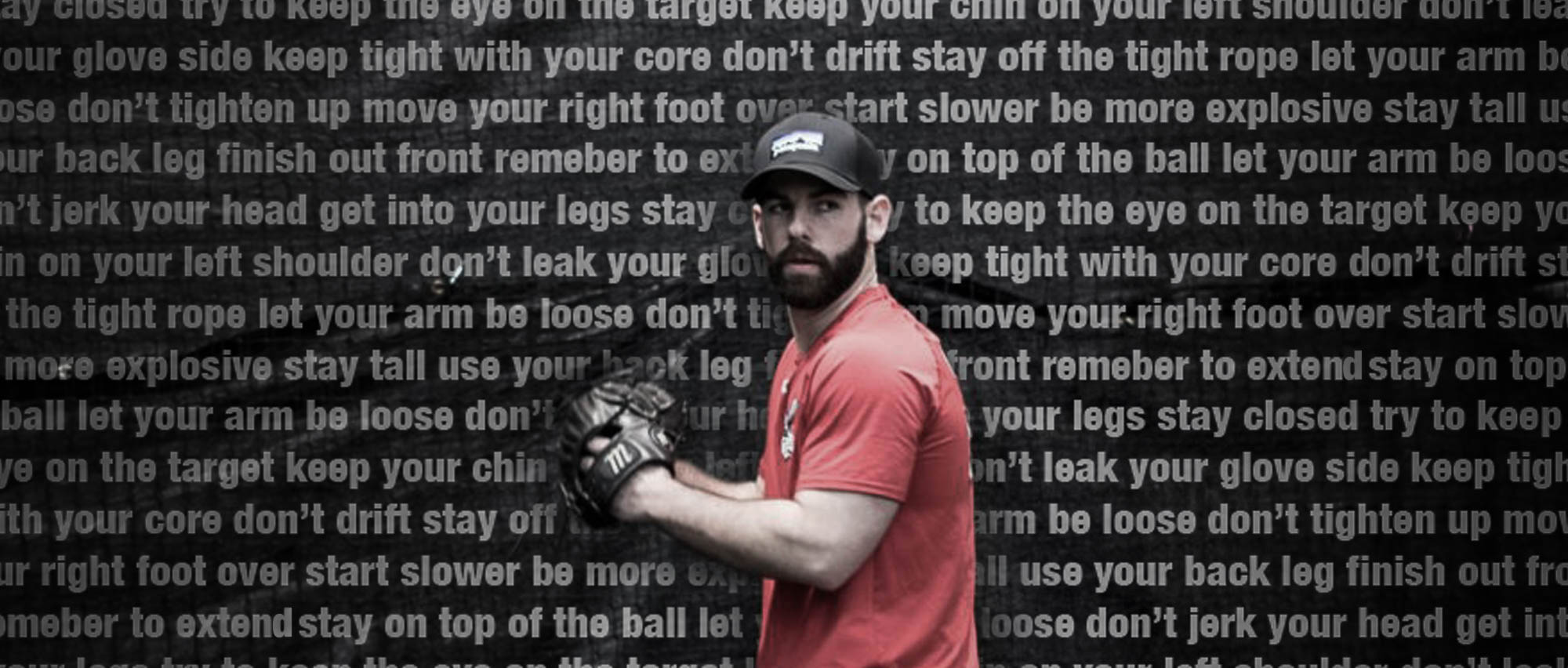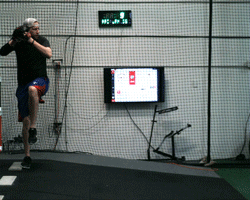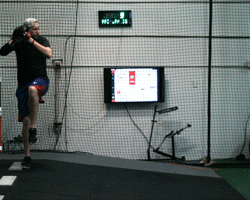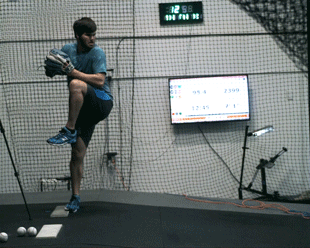A Different Model for Cueing Pitching Mechanics

Today, we are going to focus on the communication side of teaching mechanics. More specifically, we’re going to look at why we don’t agree with how most coaches believe in teaching mechanics and explaining how we teach them.
We don’t believe the traditional form of teaching mechanics is an effective way of implementing change.
We see the use of our constraint drills and Plyo Ball ® as teachers of mechanics which fundamentally change how we communicate with and cue our athletes.
Where Current Coaching Concepts Go Wrong
Most of today’s baseball coaches are a combination of two different coaching styles: experiential and method coaching.
(These definitions come from the book, Dynamics of Skill Acquisition: A Constraints Led Approach.)
Experiential coaches are the large number of coaches that were former players at college, minor, or major leagues. It’s no secret that many baseball players spend their playing careers to better prepare for a job as a baseball coach.
Method coaching breaks down the “correct” technique by piecing together specific movements in a mechanical fashion. It should be noted that all coaches use this model, whether they have played baseball or not. Essentially, coaches played baseball in the past and teaching is mostly focused on breaking down pitching mechanics into “good” and “bad” buckets. What they see as “good” or “bad” mechanics were also often taught to them.
There isn’t anything wrong with this in and of itself, the problem we see is whenever mechanical changes are attempted, they are almost entirely made by verbal cueing.
The big reason why we don’t like this style of coaching is because cues are not nearly enough to change a movement by themselves.
There is little evidence to suggest that having a coach tell a player he should change a movement pattern is effective in either immediately changing the movement or creating a lasting change.
After a few years of playing, it’s clear everyone is recycling the same cues. Maybe each coach uses the same cues, but have they all had the same definition of that cue? How is it possible to know? It’s an important question.
Below are some commonly recycled cues.
“Use your legs more.” Produce more force? Or move faster?
“Don’t fly open” Upper half or lower half?
“Stay back.” For how long?
This is where we see things go wrong; cues are often the only attempt to change mechanics and they are poorly defined.
Because nearly all coaching is verbal cues, we don’t take the time to examine their effectiveness and what we are actually asking our athletes to do.
What We Are Asking of our Athletes
While taking in any verbal cue the body has to
- Define it. (What does driving more off my leg mean? What does getting ‘on top’ mean?)
- Distinguish how that is different than what the body is already doing. (How do I know when I’ve made the change?)
- Bridge the gap from its current movement often without any internal ability to distinguish what the athlete is currently doing from what the body wants to do. (Is what I feel actually the difference that the coach wanted me to make?)
Not only do we ask athletes to make these adjustments, but the cues used in baseball are often what we consider internal cues. This means that coaches are cueing athletes to have an internal focus on specific body parts and where they need to be.
So for cues with an internal focus athletes need to
- Figure out how the movement of a part of their body is wrong.
- Guess how the new movement is suppose to feel.
- Bridge that gap, often depending on video or instructor feedback on whether improvement is actually occurring.
Telling a player he needs his arm higher, back more, or that he needs to load more in his lower half is asking more than we think because these cues are defined differently between each coach and player.
Broad cues paired with various levels of spatial awareness aren’t ideal combinations for motor learning.
Telling your player that they need to load more into their back leg is most likely to result in different movements from different players.
Not to mention many feel or internal based cues are focused on slowing down a movement that not only has a high degree of coordination difficulty but also happens incredibly quickly.
Less Can Be More
We all know that there often isn’t just one thing that a coach is telling a player to work on. It ends up being small adjustments every few pitches.
Introducing more cues leaves an athlete trying to define and distinguish multiple body movements in a short period of time, all while moving at any incredibly fast speed.
Below is a good example, from an unnamed top MLB prospect, on how introducing one fix can very quickly and easily multiply into many:
“My main thing is just using my legs better when I’m pitching, be able to drive off the mound and kind of drive the ball home as opposed to flying open which is what I’m doing a lot. I’m doing a lot of towel drills to make sure that I’m using my legs to drive forward and then stay on line to throw downhill with good plane. There’s a lot of work to be done, definitely.”
Drill choice aside, if read closely, we can see the “main thing” is using his legs better, and if we connect the dots (as originally pointed out by Casey Weathers), he’s actually working on:
- Using legs better
- Driving off the mound better
- Driving the ball to home
- Not flying open
- Driving forward
- Staying on line
- Throwing downhill with plane
It is asking a lot to tell athletes to hit seven different benchmarks of where their body should be while moving different body parts in all three planes of motion.
It’s incredibly easy to overload an athlete with cues, especially when they are being used in a reactionary measure. This means that after a pitching is thrown, a cue of advice is introduced to try and change the movement—which, like we saw above, can multiply very quickly.
Let’s compare having a goal and focusing on one cue:
With focusing on multiple cues:
This also can create an environment where everything needs to be perfect when nothing about pitching ever will be. A good pitch can be thrown, but a pitcher can still believe he’s “flown open” or “didn’t use his legs enough,” which can turn every pitch into a negative experience.
We don’t think many realize how turning pitching into a near-constant negative experience can impact someone’s development.
Lastly, introducing a significant number of cues is an easy way to coach an athlete out of whatever his natural pitching mechanics may be. At this point, many coaches teach mechanics to what “looks good,” not necessarily what may be the most efficient.
The “perfect” or “safest” mechanics have not yet been defined, but we often cue players to endlessly search for them without allowing them any ability to see what movements feel best.
For as much as we want to have one safe and effective pitching motion, because of differences in body types and limb lengths, there is a much higher chance of there being a range of “safe” and effective pitching mechanics. What that range is, we don’t know.
To simplify, we don’t like coaching only through verbal cues because
- Cues are often the only attempt to change a movement.
- What a cue actually means is poorly defined
- Cues are often used in high volume, which can easily overload an athlete
Intention & Movement
We mentioned previously how cues are also used in a reactionary manner. A pitch that doesn’t hit its desired location is usually the culprit, and a cue is introduced to fix it. This often means that if a pitcher is trying to hit the same spot for ten pitches, he may have received four or five different cues on how to “fix” his mechanics. Even though his intention during those ten pitches, to hit the same spot of the target, has remained the same.
This is often a forgotten piece of the coaching puzzle. Pitchers and coaches are on the same side with the same goals. When a pitcher misses a spot he wanted to throw to, the likelihood that the he purposefully changed his mechanics to not hit that spot is zero. As we have shown before, being off by just one degree can change the final location of a pitch by a foot!
If you tell a pitcher to throw five fastballs on the outside corner and none of them make it there, we need to understand that the pitcher is trying to figure out the best movement pattern to accomplish that task during those five pitches.
This goes hand in hand with the over-cueing that we talked about earlier. If coaches are coaching an intention (such as hitting a spot), then the athlete needs some space and time to work on accomplishing that task.
We consistently underestimate the complexity of the pitching motion and oversimplify it with broad, undefined cues.
A look at just the stride part of the pitching motion demonstrates the many moving parts in all three planes of motion.
Pitching is very difficult. Sometime we just need coaches and athletes on the same page as to what the goal for the day is and then let the pitchers explore the degree of freedom they have available in accomplishing that task.
As we’ve mentioned previously, the best “command” program for youth athletes is giving them a target, letting them throw, and not saying anything. This goes for general movement training as well.
We conveniently forget the stories of the athletes who learned to throw simply by picking a target, a tire swing or a mark on a wall, and repeatedly throwing at it. Maybe there is something to that.
How Driveline Thinks of Cueing Athletes
At Driveline, we strive to create independent, self-sufficient athletes by minimizing cues, coaching intention, and letting athletes explore movement.
In comparison to the common coaching style we have talked about throughout, our model can be considered a more “hands-off” approach. By our definition that means
- Speak less and be more focused
- Let an athlete explore the movement
This style of verbal communication is paired with changing an athlete’s environment by using our Plyo Ball ® and constraint drills.
- Introduce over/underload implements (Work on athletes proprioception; weighted balls are their own pitching coaches)
- Throw Plyo Ball ® at a wall instead of a throwing partner (It’s psychologically easier to focus on a mechanical change when you aren’t worried about over/underthrowing your throwing partner every throw.)
This means we don’t need to coach arm path as much as other coaches because the Plyo Ball ® are going to do that on their own. Our constraint drills already narrow down the focus of the movement because of the positions we teach, which allows us to be more selective and focused during verbal feedback with our athletes.
We can think of coaching athletes in our drills as teaching them what we see as fundamental good-movement principles that pitchers should have. How exactly each pitcher will perform those in their pitching mechanics, on the mound, is going to differ from athlete to athlete.
This is fundamentally different than how most coaches teach, and it often requires an adjustment period when athletes are new to it. Athletes are so use to a top-down, constant verbal-cue coaching style that being told they need to explore their own movement is a shock.
What this tends to mean is mechanical questions are athlete, rather than coach, driven. An athlete is trying to figure out an efficient way to throw, which leads him to lean on a coach as a check-in and video for feedback.
We don’t want to cue athletes into body positions we think are right for them; we want them to figure out what works best for them and that means allowing them the freedom to explore their movement.
Changing feedback from always coach-driven to mostly athlete-driven and adding in the use of video are huge parts of helping an athlete make sustained mechanical changes.
This continues when athletes pitch off the mound; we rarely make adjustments on the mound itself. We may comment on something we see, but making adjustment is for our Plyo Ball ® drills and usually introducing more mound work.
This also draws a line between competing and training. If you only make mechanical changes on a mound, then how is an athlete suppose to leave all the instruction behind during a game? When an athlete is pitching in a game, it’s time to compete, not worry about mechanical cues.
Mound work is competition practice, whether mound velo or bullpen. The Plyo Ball ® wall is for movement and mechanical work, because it separates the environments and the purposes of each.
Examples of Cues
When trying to come up with cues for athletes, it’s worth the effort to use external-focused cues over internal-focused cues. There is plenty of research suggesting that an external focus can produce more efficient movement. External-focus cues also give an athlete more freedom to explore the movement.
We’ve covered this topic on our research page, and the gentlemen at Strength and Conditioning Research also have a great summary on external cues that finished with this tidbit.
“Large, powerful, full-body movements such as plyometrics and probably also resistance exercises can be significantly enhanced by appropriate, externally-directed cues.”
If you can’t come up with an external cue, then revert to rule number one: speak less and be more focused. Only give your athletes one cue to focus on at a time.
Below are some examples of some cues we’ve used:
“Spread the floor”
“Drive through the ground.”
Some velocity-focused cues include “throw through the catcher’s glove” or “throw it through the wall.”
Athletes also tend to respond differently when told to try throwing harder, quicker, or faster. Because all athletes have their own definition, adjusting the intention and using just those three words can results in higher velocities and better movement.
Refocusing the intention to aim at eye level can also clean up some mechanical issues when working on the Plyo Ball ® wall.
We can also slightly change the environment by having an athlete hold a green ball in his glove hand, to work on positive disconnection.
Not every cue is going to work the same for each athlete. We’ve seen this in pitch design work as well as mechanical work. So it’s important to come up with a variety of cues and also communicate with the athletes on what they are thinking and feeling to come up with the best fit.
Give them one cue to work on something and let them explore the movement.
Bringing It All Together
To wrap up, we don’t agree with the way verbal cues are used in instruction because they are often the only form of feedback used to try and change mechanics. There are often poor or no definitions behind the cues that are used, and different athletes can take the same cue and give it different meanings.
Because cues are the dominant form of instruction, they are used in high volume. This makes it very easy to overload athletes with too much information. It can take away from an athlete learning what movements work best for him and instead lock him into movements that may not be ideal for him.
Pitching isn’t easy and neither is coaching it. If we want to create self-sustaining, effective athletes, we need to take a step back, be more focused on how we communicate with them, and give the space to see what movements work best.
This article was written by Associate Researcher Michael O’Connell
Want to learn more about what we know about gaining fastball velocity? Check out the wide array of blog articles we have relating to velocity building here.
Comment section
Add a Comment
You must be logged in to post a comment.



abfootdoc -
Excellent article. I could not agree more. When trying to implement a mechanical change with the plyo balls is it best to watch video on your website and emulate or are there cues that should be used for plyo work?
Thanks.
Driveline Baseball -
Some cues could be used to improve PlyoCare drills but the cue that is utilized depends on the athlete and what needs to be corrected. We never exactly emulate any throwing mechanics because each athlete moves differently. PlyoCare balls used with our constraint drills should help clean certain movements up over time.
Coaches Series: Implementing a Driveline Program at a D1 College - Driveline Baseball -
[…] positive-pattern building through the PlyoCare work helped us moved away from verbal cues that were not very effective to begin with. While the program added velocity across the board, it also added health. We did not have one player […]